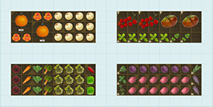Basics
- Ease of Growing
- Moderate
- Grown as
- Annual
- Days to Maturity
- 80-90 (Spring/Summer)
- Growing Habit
- Bush
- Hardiness
- Very Tender
Very tender, they can't stand cold weather or frost.
- Crops
- Spring Transplant
- Growing Season
- Long
- Cultivar Type
- -
- Growing Conditions
- Warm, Hot
Peppers originated in the tropical highlands of Central and South America and grow best with warm (70 to 80˚ F) days, cool (55 to 65˚ F) nights and high humidity. If the soil gets above 85˚ F you can cool the soil by applying mulch and watering frequently with cold water.
- Outdoor Growing Temp
- 60°F - 95°F
- Min Outdoor Soil Temp
- 65°F
The soil must be warm (at least 65° F). If necessary you could use black plastic mulch to hasten warming.
- Start Indoors
- Yes
- Start Outdoors
- No
- Light
- Sun: min. 6 hours daily (Warm, Hot)
Full sun. In very hot climates they may benefit from light shade.
- Water
- Moderate
Pepper plants are somewhat drought tolerant (especially Hot Peppers), but lack of water can affect fruiting, so they should be kept moist for best production. Drip irrigation works well with Peppers.
Sweet Peppers are particularly vulnerable to water stress when fruiting, so keep the soil evenly moist. If not given enough water, the fruits can develop a slightly bitter flavor (and may get Blossom End Rot).
Don't leave water on the leaves overnight as this encourages disease.
- Feeder
- Heavy
- Suitability
- Needs summer shade
- Small Gardens?
- Yes
- Containers?
- Yes, but will need a large one, like a half wine barrel
Choose a container at least 16" in diameter. A container with drainage holes is a necessity in order to successfully grow peppers. Cover the holes with weed cloth, newspaper or any other similar material and then fill with potting soil. Peppers love warm weather and will not thrive if temperatures are either too cold or too hot. Place peppers in full sun in warm climates, but be sure they have access to shade in hot temperatures. Keep well-watered. Stake to keep fruit off the ground, mulch for disease and weed control.
- Attracts beneficial insects?
- No
- Color
- Red
- Fruit Size
- - 5.0"
- Plant Height
- 20.0 - 24.0"
- Plant Diameter
- 10.0 - 12.0"
- Good Companions
- Catnip, Eggplant, Basil, Nasturtium, Carrot, Onion, Parsnip, Tomato, Parsley, Peas
- Bad Companions
- Finocchio, Kohlrabi
- Hardiness Zone
- 4-12
- Disease Resistance
- -
- Taste Profile
Cayenne Long Thin's fiery taste is stronger after drying.
- Rotation Group
- Fruits: Solanaceae + Cucurbits

